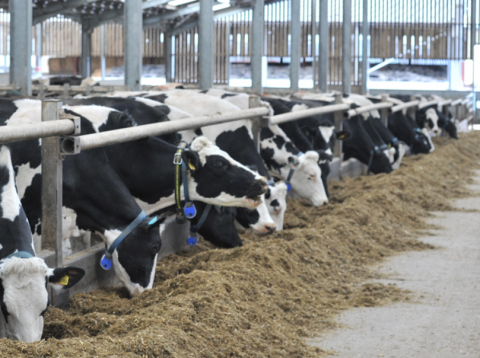20 September 2018
Assessing silage stocks on a dry matter (DM) basis and using the same technique to cost bought-in feeds is a reliable and cost effective approach for making up forage shortfalls, according to an independent ruminant nutritionist.
Although late summer rain has boosted silage crops in parts of Wales, some will still have significant shortfalls of forage for their winter needs.
To help farmers make early decisions on how to fill those deficits, Farming Connect enlisted the help of nutritionist Hefin Richards.
At a seminar in Raglan, Mr Richards advised farmers that an important first step in calculating how much feed they need to buy is to accurately assess their own forage stocks in terms of tonnes of dry matter.
This means accurately measuring clamps or weighing bales and analysing their quality.
The big variable in clamp silage is density, Mr Richards pointed out, with DM, chop length and compaction all having an influence.
“Don’t assume that all clamp silage has a density of 800kg per cubic metre or you could find yourself running out of forage,’’ he warned.
A good estimate of density can be derived from the silage DM and clamp height.
But silage density and volume alone don’t give an accurate assessment of the feed available – determining the DM content is crucial because an animal’s feed intake is limited to the volume of DM it can consume, Mr Richards advised.
“At 25% DM, a dairy cow would need to eat 48kg of freshweight forage to meet her required daily intake of 12kg DM but at 40% DM she would only need to eat 30kg freshweight. The wetter the silage the more she needs to eat to meet her DM needs.’’
Mr Richards said silage harvested in 2018 is likely to have a higher than typical DM value because of the exceptionally dry conditions.
DM intake requirements will vary according to an animal’s weight, lactation status and stage of growth.
A milking cow will typically have a DM intake of 3.5% of her bodyweight but a replacement heifer around 2.5-3%.
When the amount of DM available has been established and matched to the number of animals it needs to feed, the deficit can be calculated.
In a more normal year, options for filling DM gaps would typically include buying silage and other
forages but with their cost in many cases now double the price farmers might expect to pay in an average year and the quality variable, Mr Richards advised farmers to consider alternatives, and to cost these on a DM basis.
“The freshweight cost might look attractive but the DM percentage varies according to the product. For instance, dry grain has a high DM content and fodder beet low and while potatoes can do a great job as a forage extender they are 80% water, so in each case the product should be costed according to the amount of DM it can provide,’’ said Mr Richards.
“Molasses is a relatively high DM product - 65-75% - and the world is awash with sugar so current prices are more attractive than usual. High protein molasses-based liquids are useful for balancing higher levels of straw, but are not generally suitable for dry cows due to potassium content.
There is significant scope for feeding straw and hay to dry cows and growing animals, he suggested, and in the milking cow ration too.
“There is good supply in the system because a lot of straw that would normally have been chopped has been baled and yields have been good.
“My own gut feeling is that the price will start to creep up because of demand from Ireland and Scandinavia.’’
In a dairy system feeding moderate amounts of concentrates and with a small forage shortfall, Mr Richards recommended feeding more concentrates to displace silage as they can be paid for as they are used.
Another option is to reformulate blends to incorporate 2-3kg of a fibrous product such as soya hulls, palm kernel, lucerne pellets and nutritionally improved straw (NIS) or feeding straight cereals, he said. “It is cheaper to feed 2-4kg of oats than to buy in maize silage.’’
In high yielding herds where concentrates are fed at a high rate, Mr Richards recommended feeding more digestible fibre and straights to reduce silage inputs.
“Feeding 1.5kg of straw and 1.5kg of blend provides 2.6kg of DM which is equivalent to 9kg of silage at 30% DM,’’ he explained.
“If you can make subtle changes early in the year it is better than being forced to make drastic changes later if your silage runs out.
“If also gives the flexibility to update the ration if you find yourself in a better forage position than anticipated.’’
For youngstock, Mr Richards recommended straw or hay-based diets together with 4kg of a moderate energy 20% protein mineralised blend or compound. “Youngstock will grow 0.8kg a day comfortably on this and it is a very consistent and reliable way of saving silage.’
For suckler beef cows, he advised weaning spring-calving cows early and feeding ad lib straw with 2.5kg/day concentrates if they have gained good condition on grass.
In beef systems, target the best quality forage at growing animals, he said.
In intensive beef finishing systems, double the amount of blend in the diet to get animals finished 6-8 weeks early.
Farming Connect Dairy Technical Officer Imogen Ward, who organised the meeting, said the message was clear – feed budgeting is essential. “It is not difficult or time consuming – establish what you have got in the clamp, work out if you have enough for the different stock groups. If you understand what you have and what you need you can budget for these shortfalls and work out the most cost-effective approach to dealing with them.’’
Visit the Farming Connect website to access our Forage budget calculators.
Funding for the project has been provided by the Welsh Government’s Rural Communities Rural Development Programme 2014-2020.


